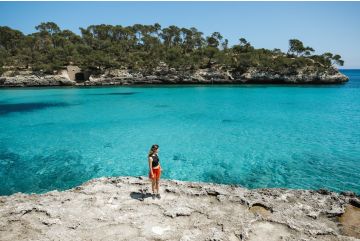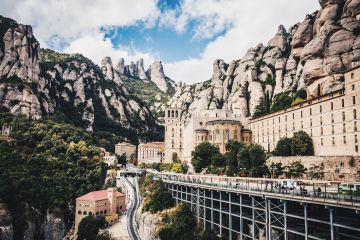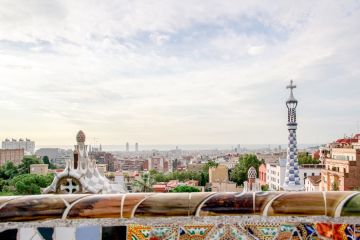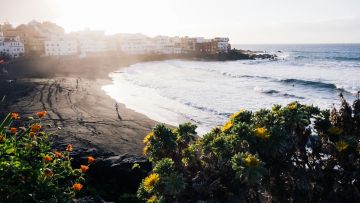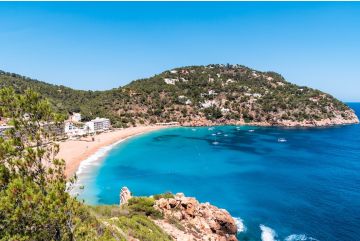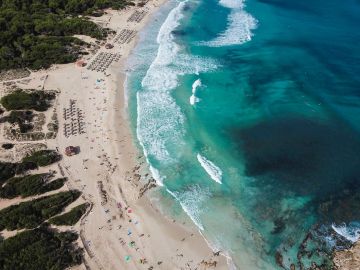- Day 1: Plaza Catalunya, Rambla and Gothic Quarter
- Day 2: Sagrada Familia, Parc Güell, Casa Batlló, Casa Mila
- Day 3: Picasso and Miro, aquarium and zoo, Montjuic, and Tibidabo
- Day 4: Mountain and Montserrat Monastery or Dalí Museum
Day 1: Plaza Catalunya, Rambla and Gothic Quarter
Barcelona is not only about Gaudi, although there are many of his creations here and all of them are indescribably beautiful. Barcelona is about luxurious Gothic quarter, the discreet charm of classicism, and the unique modernism of Gaudí. Barcelona is about many kilometers of sandy beaches, so you can change location every day. Barcelona is about rivers of sangria and mountains of delicious tapas in crowded tapas bars. Barcelona is about a stormy stream of people flowing along the colorful Rambla, and gorgeous views from the sacred mountain of Tibidabo. Barcelona is always bright, loud, beautiful, and very sunny.
And now we will tell you more about the most interesting sights of Barcelona so that you can see all the most important things.
If it's your first day in Barcelona, start with the beaches. The city has eight beaches, and each has its own vibe. First, go to the quiet San Sebastia, where you will find everything you need for a perfect seaside holiday. Also, one of the best hotels in the city and even in Spain is located there. It is called W Barcelona. This hotel looks like a glass sail that reflects the sun's rays and decorates the entire coastline.
The next day, San Sebastia can be changed to Barceloneta, where there is always fun, dance, and life. Then go to the sedate and imposing Bogatell, take a book or magazine with you, order a cocktail, and slowly get covered in a golden tan under the gentle rays of the Barcelona sun.
Our Best Barcelona beaches guide will help you to find a perfect place to swim and sunbathe.
As the wise king Solomon said, “There is a time for everything and a season for every activity under the heavens”. And now it’s time to swim and sunbathe, walk along the fabulous Rambla, and look at Park Güell.
Placa de Catalunya and the Rambla
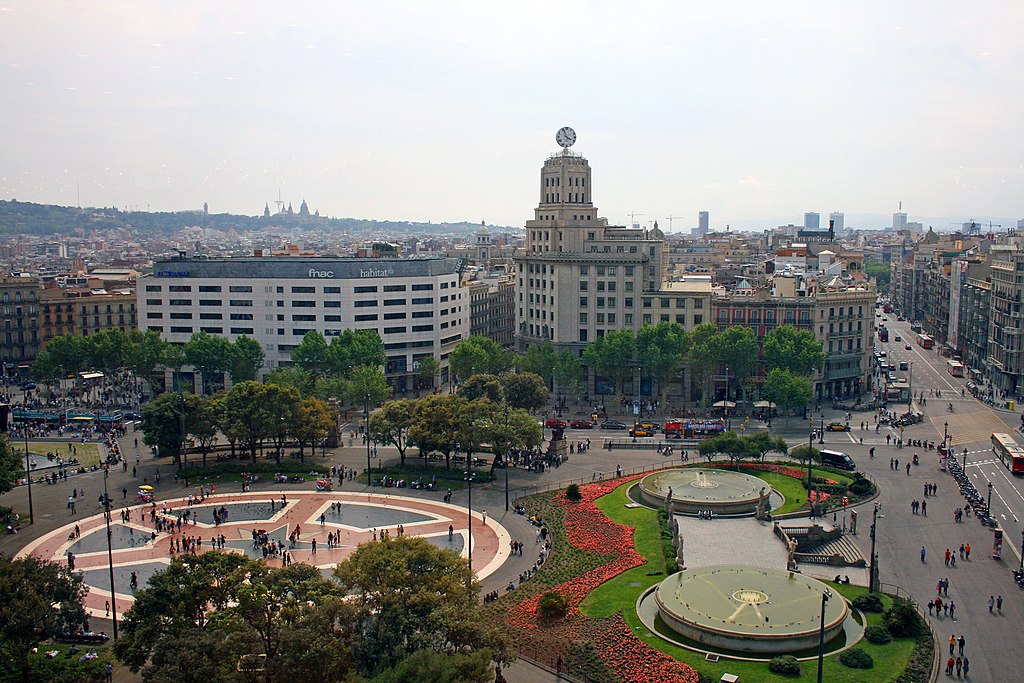
Author: Bert on Wikimedia
The Rambla, the main walking street of the city, is located between Plaça Catalunya or Plaza Catalunya and the city port.
Come here and you will find yourself in a whirl of fun, color, and sound. Come here also if you are looking for a nice place to eat or drink your glass of sangria. And finally, come here if you are bored and not sure what you want to do. And also if the souvenirs have not yet been bought, but you still have some money left.
On the Rambla, you will meet flamenco dancers, street artists who paint portraits, and mimes who depict people passing by. You will dive into aromas and guitar sounds that come from lovely restaurants, and all these colors, sounds, and smells take you into the whirlpool of Barcelona life.
Start your walk from Placa de Catalunya. This is a large transport hub. There is a metro, intercity trains, and several bus stops.
There are a couple of shopping malls in the square, such as El Triangle and El Corte Inglés. Nearby you will find the huge Apple Passeig de Gràcia, which is worth visiting even if you don't need a new iPhone - just look at the design and the interior. Another important point is the official store of FC Barcelona called the Barça Store Passeig de Gràcia. It is located 300 meters from the square and is a certified paradise for football fans. More precisely, a branch of paradise, because the highlight of the program for any fan is the Camp Nou stadium, which also has a museum. Some say that this stadium is more than just a stadium, just like the Barcelona club is more than just a club. But we deviated from the route.
Best things to see on the Rambla
Rambla is divided into segments, each has its own name - Rambla Canaletes, Rambla Estudios, Rambla de las Flores, Rambla de los Capuchinos, and Rambla de Santa Monica.
Rambla Estudios: Church of Our Lady of Bethlehem
This church, Església de la Mare de Déu de Betlem, was built in 1732 in the Spanish Baroque style. Admire the unusual facade, statues made of ceramics, marble, and gold, luxurious ceilings and corridors.
Rambla de las Flores: Viceroy's Palace and Boqueria Market
On the Rambla de las Flores, you will find colorful souvenir shops where you can buy something to remember a wonderful vacation on the Mediterranean coast, fragrant flower stalls, and the huge Boquería market, where you may buy the freshest vegetables and fruits, meat and fish, sweets and drinks, and of course spices.
Boqueria is considered to be one of the oldest markets in Spain and it is definitely one of the most beautiful. The prices here are not low, but there is everything and the quality is excellent.
Enjoy one of gastronomic tours such as Paella Cooking Experience & Boqueria Market Tour for 58 euros or Half-Day Spanish Cooking Class & Boqueria Market Tour for 94 euros. Taste Barcelona!
The Palace of the Virreina or the Palace of the Vice Queen of Peru decorates the Rambla de las Flores even better than roses and peonies. Behind the discreet façade a magnificent baroque hides. This place is also a center of modern culture, which often hosts exhibitions of contemporary artists and photographers.
Rambla de los Capuchinos: Teatro Liceu, Mosaic by Joan Miro and Palau Guell
The Rambla de los Capuchinos opens the door to the world of art.
The artist Joan Miro is the national pride of Catalonia. His surrealistic paintings are kept in Joan Miro Foundation. And on the way to the museum, you can walk along one of his masterpieces, because this masterpiece lies right under your feet. A colorful mosaic has been decorating the Rambla since 1976, and one of the mosaic pieces even has the artist's autograph.
Such stars as Fyodor Chaliapin, Montserrat Caballe, and Placido Domingo performed at the Teatre del Liceu. The theater has great acoustics, chic interiors, and an amazing story. If you love opera, buy a concert ticket, and if you don’t like it, go to the ticket office to admire the ceilings and stucco on the walls.
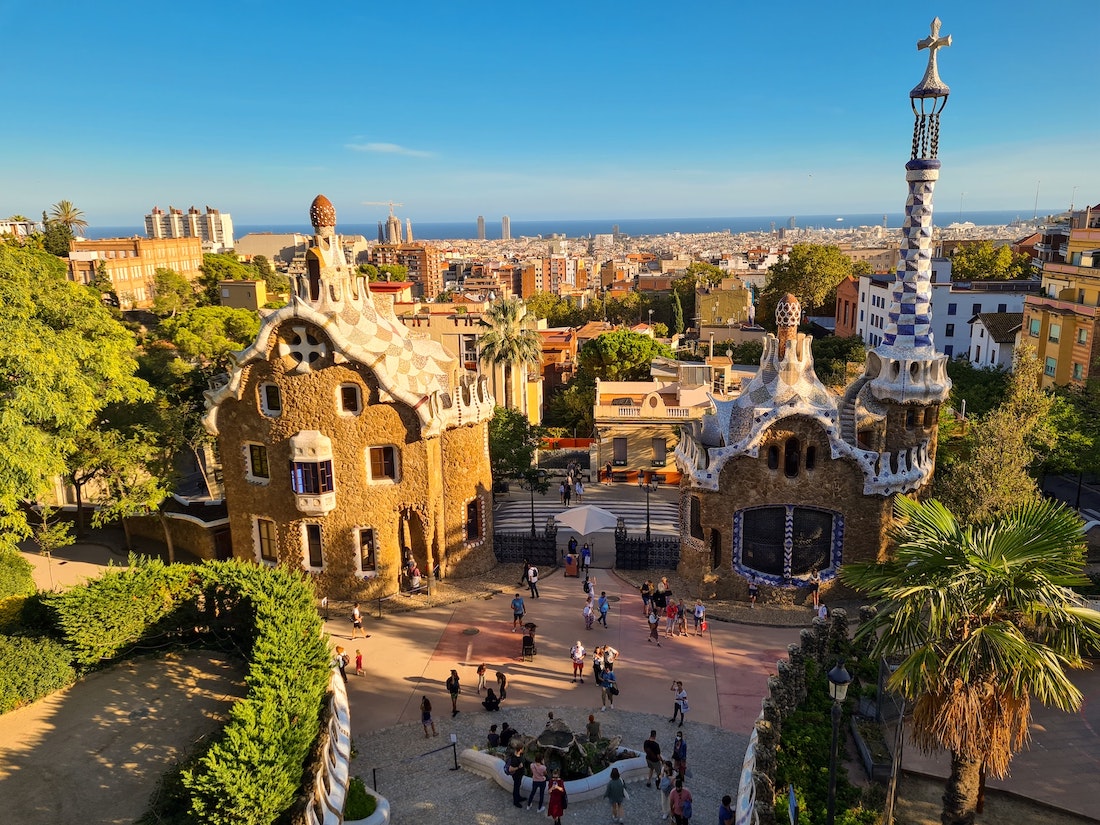
Author: Martijn Vonk on Unsplash
Palau Guell was built by Antonio Gaudí for Eusebi Güell, the same man who ordered the Parc Güell project. Today you can go inside the palace to admire the neo-Gothic modern, seasoned with the futuristic ideas of Gaudí. Or you can look at the building from the street, and leave a closer acquaintance with Gaudi for the next day or the next visit.
Rambla de Santa Monica: Columbus Monument
At the very end of the Rambla, a seaside square is located. And in the middle of it, an 80-meter monument stands. The statue of Christopher Columbus stands at the top of the monument and looks into the distance. There is an observation deck on the top of the monument from where you can see the entire city center, cathedrals, ports, beaches, and the endless blue sea.
Barri Gotic
A short walk away from the Rambla and you are in the Gothic Quarter or Barri Gotic. In the Middle Ages, the whole life of the city was concentrated here. Divine services were held in majestic temples, conspiracies were organized in dark corners, and contracts were concluded in luxurious halls.
In the Gothic Quarter, you will see beautiful architectural examples of the Classical and Baroque eras, so the quarter is much more multifaceted than you might expect.
Cathedral of the Holy Cross and Saint Eulalia
People often think that the main cathedral of Barcelona is the Sagrada Familia. But in reality, the Cathedral of the Holy Cross and Saint Eulalia or Eulalia (Catedral de la Santa Creu i Santa Eulàlia) is the main one. This temple was built in 1298. It is interesting for its solemn Gothic architecture. Admire an intricate portal and a beautiful rose wind, and explore interior decoration - high vaulted ceilings, sculptures of saints, and an altar. 13 white geese live in one of the courtyards. According to legend, at the age of 13 Saint Eulalia was martyred, and white geese symbolize her innocence.
There is an observation deck on one of the towers of the temple. It offers a magical view of the Gothic Quarter and the center of Barcelona, and it looks especially beautiful at sunset.
Basilica de Santa Maria del Pi
The name of this wonderful church means St. Mary of the Pine. Many centuries ago, a pine forest grew in this place. Then it was cut down to build a church. In memory of the forest, a pine tree was planted in front of the temple.
This cathedral was built here in 1320. During its long life, the building suffered many commotions: an earthquake, a fire, a powder keg explosion, and, finally, a complete reconstruction.
Pay attention to the Gothic style, an unusual wind rose at the entrance and a portal with columns, and then admire the lancet windows, stained-glass windows, and sculptures of the Virgin Mary and other saints.
The most unusual part of the temple is its bell tower. It has eight corners, so it resembles a huge brick chimney of some kind of factory or a strangely shaped house, but not a bell tower. There is an observation deck at the top of the bell tower from where you can see the whole city and even the sea.
Concerts are held in the temple in the evenings, prices are very modest so anyone may come.
The entrance to the temple costs 4.50 euros, and the entrance to the observation deck costs 9 euros.
Saint James's Square
The central square of the Gothic Quarter is called Plaça de Sant Jaume or Saint James's Square. Nearby you will find the city hall and other municipal buildings, as well as cafes, restaurants, and souvenir shops.
The style of the city hall may be classified as classicism. The columns and the general appearance of the building, reminiscent of a building from ancient Greece, tell us about this. All the buildings on the square are built of light stone, their lines are smoother, and their decorations are modest, unlike the majestic buildings of the Middle Ages.
Art-cabaret Els Quatre Gats
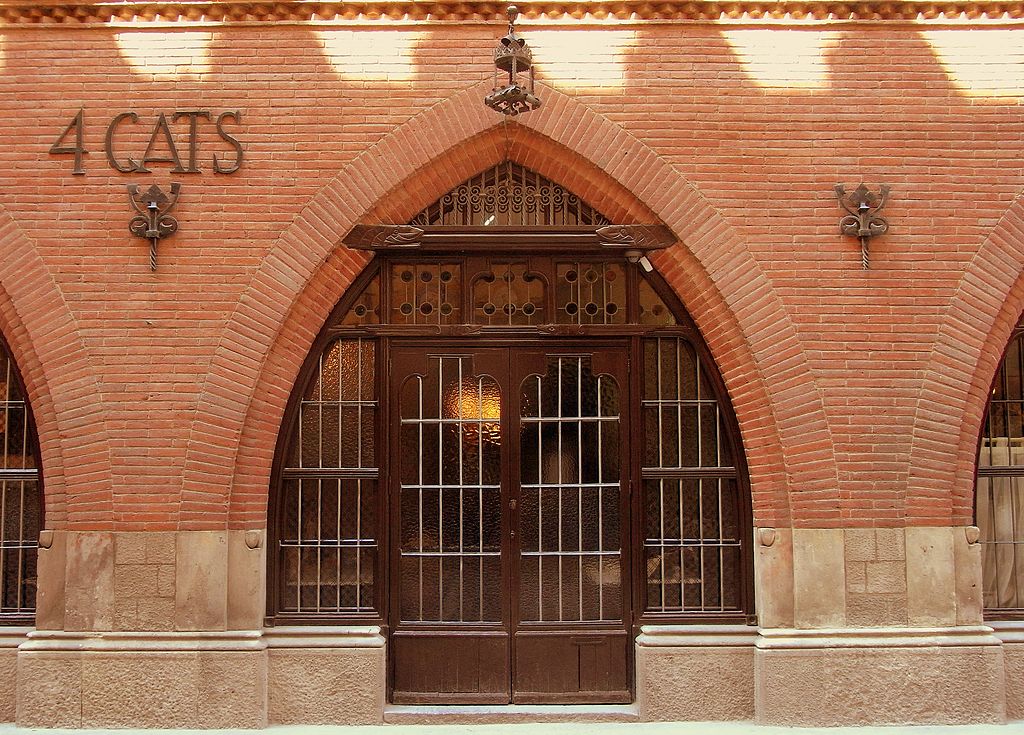
Author: Jaume Meneses on Wikimedia
The cult place of Barcelona Four Cats or Els Quatre Gats is located on one of the streets of the Gothic Quarter. The cabaret cafe was created after the French cabaret Black Cat and was used for the same purpose - the Spanish bohemia meetings. Picasso held his first exhibition here, Antonio Gaudi and many other artists of that time came here to have lunch and discuss their future projects.
People come to Els Quatre Gats to see the classic modernist interior, look at the interesting paintings on the walls, sit in the muffled light and order traditional food. In the evenings, the cabaret offers concerts and bright shows, so better book tables in advance.
Plaça Reial and Placa del Rei
Another beautiful square is called Royal (Plaça Reial). It looks like a Venetian courtyard. Buildings with arches and galleries are built along the perimeter, and sprawling palm trees are planted in the center of the square. There are tables of street cafes under the shades of palms where you can relax and drink morning coffee with choux churros.
500 meters away from Royal Square King's Square (Placa del Rei) is situated and they are often confused. The Museum of the History of Barcelona (Museu d'Història de la Ciutat Barcelona) is located on King's Square. Go there to see ancient Roman ruins and the old city walls, as well as sculptures, coins, dishes, jewelry, clothes and shoes, art, and weapons telling about the history of the city.
The entrance costs 7 euros for adults and free for children under 16.
On Sundays from 15.00 to 19.30, the entrance is free.
Try one of the Gothic Quarter tours, for example 2-Hour Gothic Walking Tour for 25 euros or fascinating Sagrada Familia & Barcelona Full-Day Tour which includes the Gothic Quarter attractions for 88 euros.
Day 2: Sagrada Familia, Parc Güell, Casa Batlló, Casa Mila
We propose to dedicate the second day in Barcelona to architecture, specifically to the great Catalan creator Antonio Gaudi.
Sagrada Familia
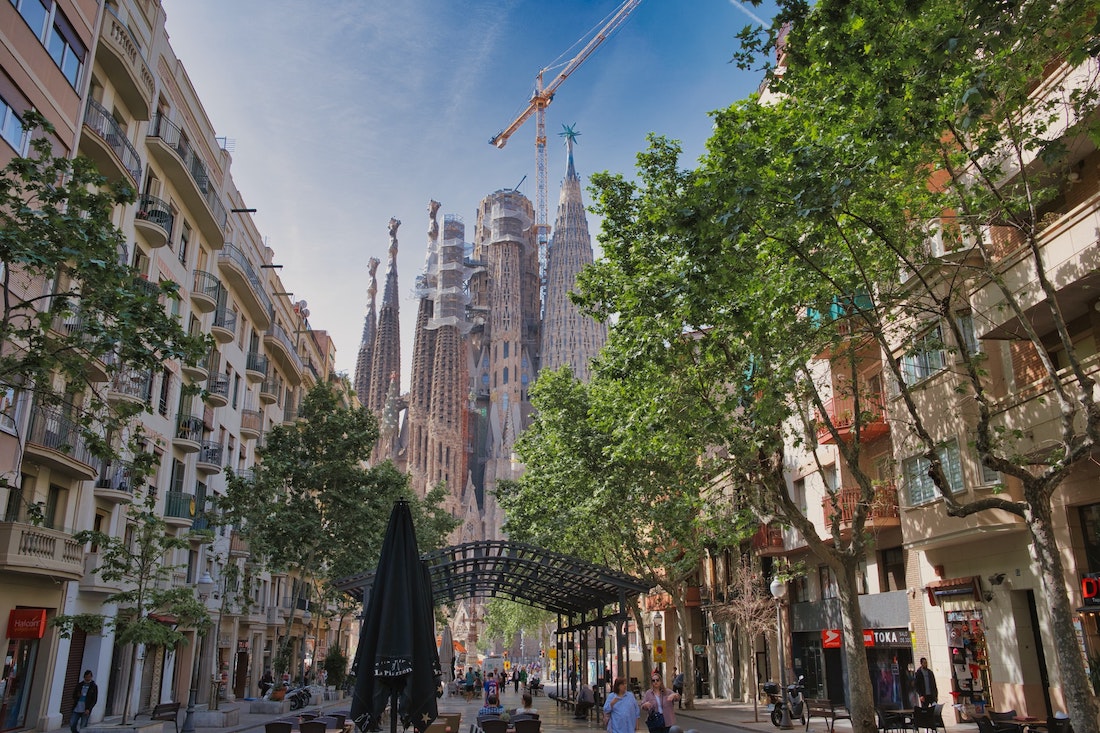
Author: Yu on Unsplash
“Where is Gaudi?”, - you ask. "Here he is!", - we answer. The magnificent and at the same time absolutely unlike the Sagrada Familia.
The idea to create the cathedral belonged to the local charitable organization Associació de Devots de Sant Josep. They changed several architects and finally, in 1984 Antoni Gaudí got the job. The budget was initially modest, but Gaudi received a charitable donation, which allowed him to give free rein to fantasy. So much so that construction continues to this day. The ambitious project is expected to be completed in 2026.
Sagrada Familia style and idea
Antonio Gaudi worked on the construction of the temple for forty years. He literally lived there, and he had only one purpose. He wanted everyone who came to the temple to be able to see the story of Jesus Christ. All the facades and interior decoration of the temple scream about the greatness of God. Here are the frescoes about the birth of Jesus Christ, here are the testimonies of the sinfulness of people, here is the image of God's love for each person and the death of Jesus Christ on the cross for the sins of each man. Towers piercing the sky, high bell towers, marvelous frescoes, bright stained-glass windows and wonderful sculptures tell about the incredible greatness of God and his wonderful love.
There is no particular style in Gaudí's work. He just followed his imagination. Looking at the temple, you see how the majestic Gothic flows into the artsy Baroque, and it turns into a modest Byzantine style with oriental motifs. And the whole building lives in the harmony of styles.
Gaudi knew that he would not have time to complete the construction and therefore left a huge number of the most detailed plans and drawings, where he specifically painted the further progress of work.
Opening hours and entrance fees
The temple is open from November to February from 9.00 to 18.00, in March from 9.00 to 19.00, from April to September from 9.00 to 20.00, in October from 9.00 to 19.00.
December 25 and 26 and January 1 and 6 the temple is open from 9.00 to 14.00
The entrance ticket costs from 20 euros for a basic ticket to 39 euros for visiting the cathedral and towers.
You may buy tickets at the box office of the cathedral or online.
Buy Sagrada Familia Entry Ticket with Audio Guide or Sagrada Familia Tour with Optional Tower Access.
Park Güell
Park Güell is another place where the fantasy of the architect Gaudí will surprise you.
In the late 19th century, the idea of a garden city became popular. In a city of the future, a large park was located in the center, residential areas were built around the park, factories and plants were located behind them. In 1901, Catalan businessman Eusebi Güell got the idea to make such a city near Barcelona and suggested Antoni Gaudí be a part of his plan.
It took ten years to build a park and several houses. Eusebi Güell believed that people would rush to buy such a wonderful property, but the idea failed. People wanted to live in their usual homes and go to their usual jobs. As a result, one of the three houses was bought by Gaudi himself, one of his friends settled in the second, and the third was bought by Eusebi Güell.
There are two small elegant houses with roofs topped with spiers at the main entrance. The style of the houses reminds of Danish or Swedish architecture, and it looks like the building is sculpted from gingerbread dough and filled with glaze.
The park has a lot of unusual details. For example, the famous mosaic bench that surrounds the main terrace. The bench is decorated with shards of tiles and crockery shards. The workers collected materials for decoration all over the city, they even searched them in trash cans. The staircase leading to the terrace with a bench is also decorated with a varicolored mosaic salamander.
Another attraction of the park is called the Hall of a Hundred Columns, although there are only 86 columns in it. The columns look very modest, but the ceiling is again decorated with mosaics and made in an unusual manner.
Bird nests are special clay constructions that decorate palm alleys. These are original walls built into the natural hill on which the park stands. The "nests" are lined with small stones, and huge palm trees are planted behind them, creating a pleasant shade and a luxurious subtropical atmosphere.
Opening hours and entrance fees
From 15.02 to 28.03 the park is open from 8.30 to 18.00.
From 29.03 to 26.04 the park is open from 8.00 to 19.30.
From 27.04 to 23.08 the park is open from 7.30 to 20.30.
From 24.08 to 24.10 the park is open from 8.00 to 19.30.
From 25.10 to 31.12 the park is open from 8.30 to 17.30.
Most of the park is free, but the central part, where the main attractions are located, is paid. You can enter the paid part through the main gate.
A ticket at the box office costs from 13 euros, or you may buy the ticket online.
Park Guel skip-the-line ticket and the guided tour costs 24 euros.
You may also buy combined Skip-the-Line Sagrada Familia & Park Güell Guided Tour for 82 euros. It allows you to visit the popular Barcelona attractions avoiding long lines and learn more interesting facts about the life and art of Antonio Gaudi.
Casa Batllo
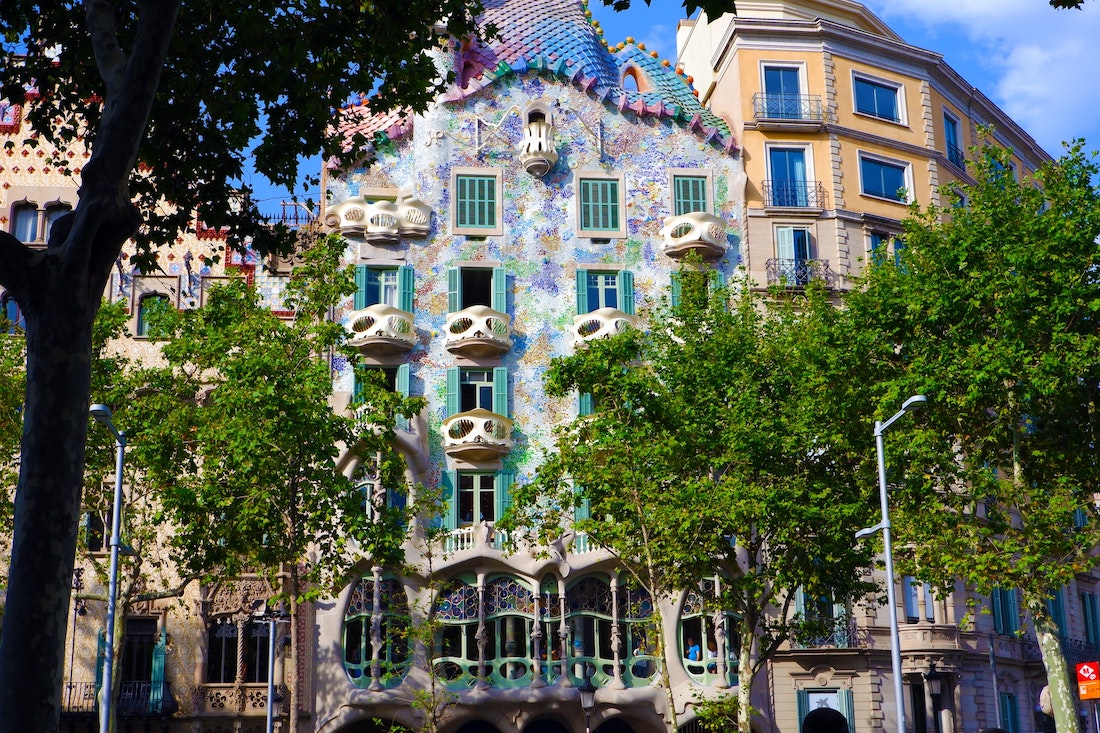
Author: Ruggiero Calabrese on Unsplash
Casa Batllo is located in the center of Barcelona, 700 meters from Placa de Catalunya. It was built in 1877 for the Catalan businessman Josep Batllo y Casanovas, and in 1904-1907 the building was rebuilt by Gaudí. He completely changed the facades, replanned and completed the floors, and added a terrace, an attic, and a spacious courtyard.
Ventilation and lighting were extremely important for the architect. Every building he built is always cool in summer and warm in winter and at any time of the day light streams from the windows. Batllo's house was no exception.
Gaudí plays with the color of the façade, which changes from beige to smoky blue, and the roof looks like the scales of a mythical dragon. The lines of windows and balconies imitate smooth natural features. The frames are painted aquamarine, and the balustrades are made of bone color. The whole building is painted in soft shades and it seems that it is shrouded in haze.
The building is generously decorated with forged elements, stucco and stained-glass windows. Inside you will be amazed by spacious halls with high arched ceilings and massive doors, an outlandish lamp in the form of the sun, and a room that looks like a cave.
You should also go out onto the balcony and go up to the roof to take a closer look at the tile scales and enjoy the panorama of the central part of Barcelona.
Opening hours and cost of visiting
The museum is open every day from 9.00 to 21.00
The cost of visiting is 35 euros.
Tickets can be purchased at the box office or you may buy them online if you don't want to stand in line.
You may buy a combined ticket to Sagrada Família, Park Güell, and Casa Batlló Tour for 169 euros.
Casa Mila
Mila's house is also called La Pedrera, which means "quarry". If you look closely, it becomes clear why. The powerful facade of gray concrete is decorated with balconies with wrought-iron gratings. The wave-shaped building seems to flow along the boulevard. The building is crowned with a roof with a spacious terrace. It is lined with mosaics and decorated with colorful chimneys and sculptures.
The house has many windows and a well-thought-out ventilation system, which, as we have already said, was very important for the architect. The building is cool in summer, warm and light in winter, and very comfortable.
There are a couple of courtyards inside the building where you can wait out the summer heat. Rounded staircases are decorated with plants, which creates the effect of a winter garden.
The Gaudí Museum is located in the House of Mila, and the cost of visiting is included in the price of the entrance ticket. There is an observation deck on the roof and a visit to it is also included in the ticket price.
Opening hours and cost of visiting
From November 4 to February 27, the museum is open every day from 9.00 to 18.30
From February 28 to November 1, the museum is open every day from 9.00 to 20.30
Check the official website for schedule changes.
The entrance ticket costs 22 euros. Children under 6 years old visit the museum for free.
Tickets can be purchased at the box office or buy them online. This will help you avoid the lines.
Day 3: Picasso and Miro, aquarium and zoo, Montjuic and Tibidabo
We propose to dedicate the third day of our walk around Barcelona to art and get to know Pablo Picasso and his colleague Joan Miró better. After a solid portion of the art, cool off in the shade of Ciutadella Park and visit the local zoo or go to the underwater world of the city Aquarium. Finish the day with the picturesque landscapes from the observation deck at the Columbus Monument. Or you can climb even higher - on the Barcelona mountains.
Picasso Museum and Joan Miro Foundation
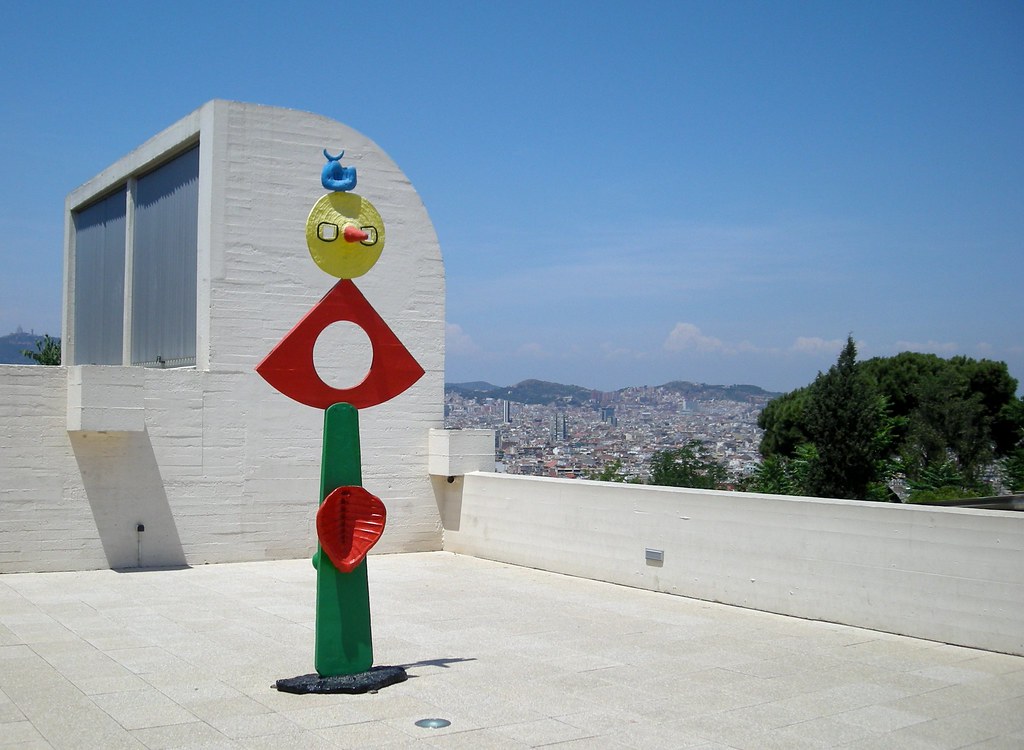
Author: malouette on Flickr
Picasso Museum
Picasso museum is a place where the largest collections of Picasso paintings are saved. You will find them in the Picasso Museum, located in the Gothic Quarter.
Barcelona became a special city for Picasso. His first exhibition was held in this city, and during creative meetings at Els Quatro Gats, he met many artists.
In 1960, Picasso's close friend Jaime Sabartesse donated 574 works to the museum. After Jaime's death, Picasso donated another 900 of his paintings to the museum. Today, the museum's collection includes 3,500 works, including paintings, drawings, sculptures, and ceramics. The beginning of the artist's career, a period between 1890 and 1917, is especially vividly presented in the museum.
The greatest pride is the cycle of works "Las Meninas". These are the artist's experiments on the theme of Velazquez's painting "Las Meninas".
General ticket price is 12 euros. You may buy a usual ticket or a special Barcelona Museum Pass which allows you to enter six best Barcelona museums: Museu Picasso of Barcelona, Museu Nacional d’Art de Catalunya, Fundació Joan Miró, The Centre de Cultura Contemporània de Barcelona, Museu d’Art Contemporani de Barcelona, and Fundació Antoni Tàpies.
Joan Miro Foundation
Joan Miro Foundation is a home for the artworks of another avant-garde artist named Joan Miro. Even if you are not familiar with Miro's work, but are delighted with Picasso and want to learn more about abstract art and Catalan art, go to this museum. And the museum building itself is a masterpiece of modern architecture so it is also a must-see. The museum is located in Montjuic Park, we will tell you about it later.
Joan Miro was born, lived, and worked in Barcelona and later in Paris. In 1920, the young artist met Picasso, and in 1921 he entered the shaky ground of abstractionism. Over time, surrealism became a wide road for him, and he walked along it until the end of his life.
Miro has established himself as a talented artist, sculptor, and decorator. He painted the walls of expensive hotels and restaurants, created frescoes and even sculptures, painted anti-fascist posters.
The entrance ticket costs 14 euros. You may buy the ticket online.
You may also buy a special Barcelona Museum Pass which allows you to enter six best Barcelona museums: Fundació Joan Miró, Museu Picasso of Barcelona, Museu Nacional d’Art de Catalunya, The Centre de Cultura Contemporània de Barcelona, Museu d’Art Contemporani de Barcelona, and Fundació Antoni Tàpies.
Barcelona Aquarium and/or Zoo
After such an eventful day in the museums, we invite you to relax in the bosom of Mother Nature. You can simply go to the park, for example, to the fortress of Montjuic, on which the Miró Museum is located. Or you can dive into the underwater world in the city aquarium or visit the kingdom of animals in the Barcelona Zoo.
Barcelona Aquarium
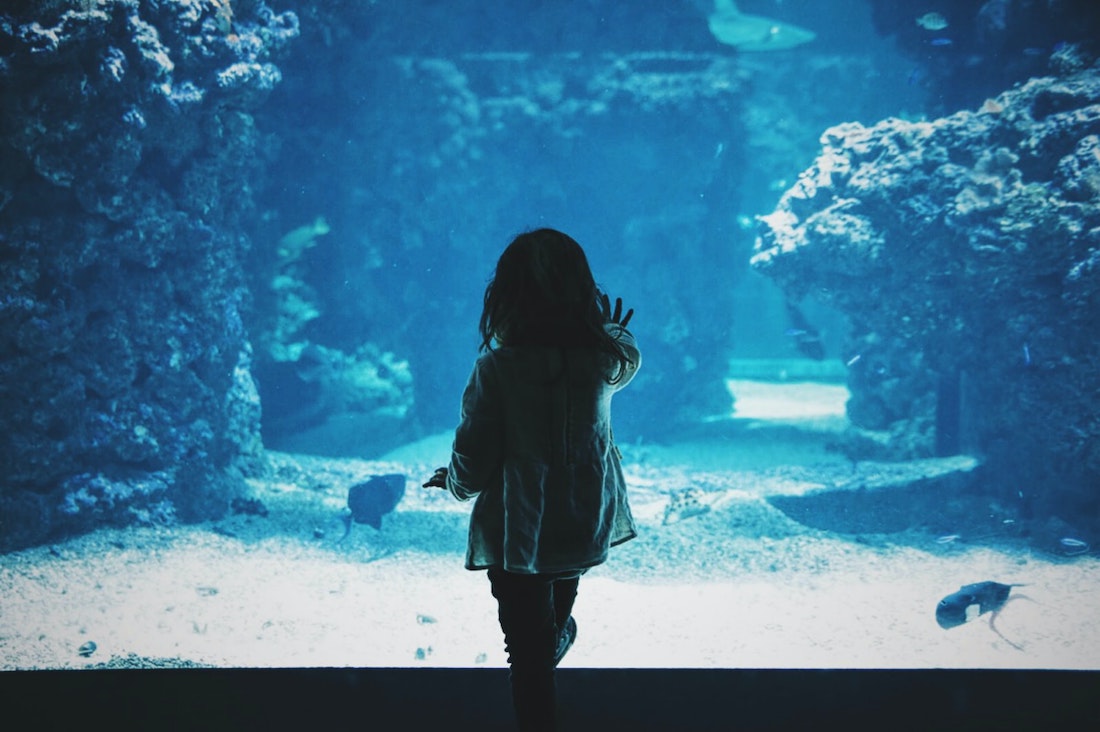
Author: Caroline Hernandez on Unsplash
Barcelona Aquarium is considered one of the largest in Europe. This is a perfect place for those who are tired of big city life and want to relax.
The aquarium has a large underwater tunnel, where you get the impression that you are walking along the seabed, and fish are swimming above you. A moving walkway goes along the tunnel and it creates the feeling that you are not a person, but a real member of the underwater community, who does not walk but slowly swims along with everyone.
Here 35 aquariums with 11 thousand marine inhabitants are waiting for you. Each aquarium has a special microclimate so that all fish feel very comfortable and almost at home. Toothy sharks and dangerous stingrays, graceful moray eels and tenacious octopuses, clumsy crabs and prickly sea urchins, clumsy turtles and funny penguins joyfully receive guests.
The aquarium has a museum where you can watch movies about the underwater world and learn many interesting facts. There is a cafe and a children's play area. You can buy special food for fish, feed and even touch the carps. Children are usually delighted with a real submarine that you can enter and even push the buttons in the control room.
Opening hours and prices
The aquarium is open every day, but opening hours may vary depending on the season. The Aquarium always opens at 10.00 and closes in different seasons at different times, but always between 19.30 and 21.00.
The ticket costs 21 euros for adults, 16 euros for children from 5 to 10 years old and 8 euros for children from 3 to 4 years old. Tickets can be purchased at the box office or you may buy them online if you don't want to stand in line. Online tickets are convenient because they do not even need to be printed, just save them to your phone. Buy a ticket.
Barcelona Zoo
The City Zoo is located in Ciutadella Park, 1.5 km from Plaça de Catalunya.
Relax in the shade of luxurious plane trees on hot sunny days, and if you came here in winter enjoy a nice walk with dressed-up peacocks. The zoo is home to two thousand animals, about 300 species.
There are no cages in the zoo at all. Small animals simply walk among visitors, and large animals are separated from people by ditches with water or low wooden fences. For each species, the most natural living conditions are created. Giraffes and elephants walk on the prairie, hippos relax in the big lake, llama-guanaco thoughtfully chew tasty green grass, huge turtles are slowly crawling along the paths, and bright parrots are sitting on the branches of trees.
The zoo has a lot of entertainment for the whole family: you can watch how dolphins play, take part in breakfast with penguins, watch the training of elephants, and children may take part in daily educational walks around the zoo so that children learn to understand and love nature.
Opening hours and cost of visiting
The zoo is open every day from 10 am, and the closing time varies depending on the season, on average until 17.30-19.00.
The entrance ticket costs 21.40 euros. There are discounts for children from 3 to 12 years old. Children under 3 years old visit the zoo for free.
You may buy a ticket at the box office or online. Online tickets allow you to skip the line. You do not need to print them, just show your ticket on your phone at the entrance.
Observation deck on the top of Columbus Monument
If you walk along the Rambla toward the sea, you come to the sun-drenched Plaça Portal de la Pau, in the middle of which the monument to Columbus stands. And ahead you will see the Aquarium and the Barceloneta beach.
A giant monument has stood on the square since 1988. The height of the monument is 60 meters. A powerful Corinthian column crowned by a 7-meter bronze Columbus occupies 40 of them. According to the author's idea, he points to the New World with one hand and holds a scroll in the other. But in fact, the direction where Columbus is pointing is not the New World, but Algeria.
The monument commemorates the return of Christopher Columbus from the First Voyage to the shores of America. It lasted eight months, after which he arrived in Barcelona to report to Queen Isabella I and King Ferdinand II, who financed the voyage.
There is an observation deck at a height of 60 meters. From there you can see the whole center of Barcelona with its cathedrals and mansions, the surrounding hills and mountains, you can see sandy beaches and yachts in the port, in general, the view is incredible.
Opening hours and prices
The observation deck is open every day from 8:30 to 20:30.
The entrance fee is 6 euros.
You can buy an entrance ticket at the box office downstairs or buy it online in advance and then just save it to your phone. This is a perfect way to avoid the lines.
Montjuïc Fortress and/or Mount Tibidado
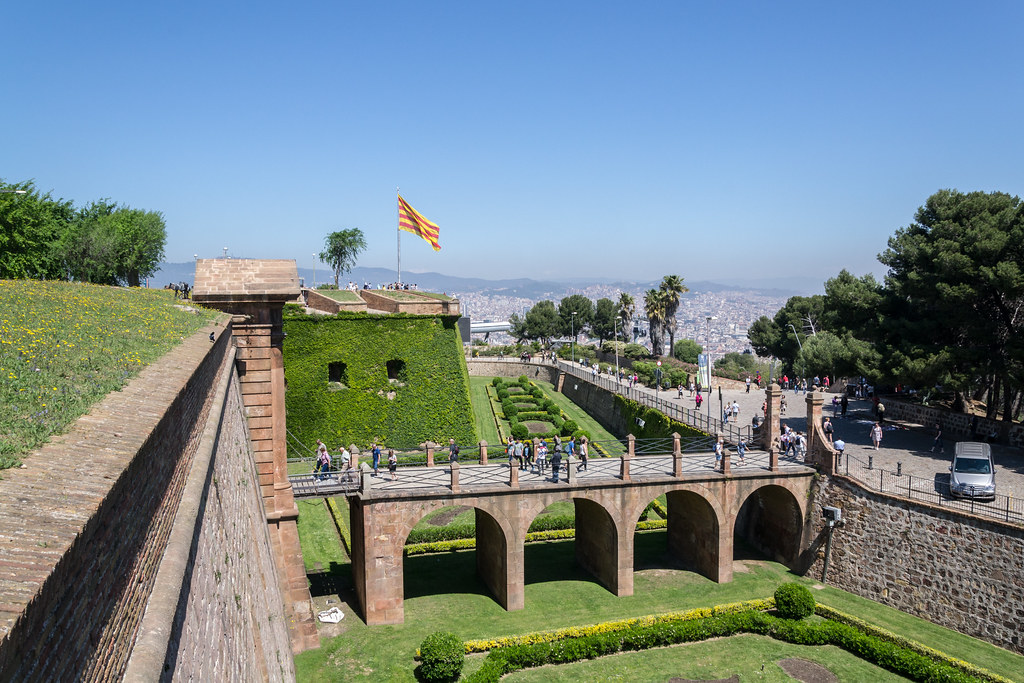
Author: Domenico Convertini on Flickr
Mount and Fortress of Montjuïc
Monjuïc is not too high, but a very famous mountain in Barcelona. It is 3 km from the city center. Montjuïc is a whole complex of attractions. There is a large park, sports complexes left after the 1992 Olympics, an old fortress, an observation deck, and several museums: the Military Museum and the Joan Miró Foundation, which we told you about above.
It is a good idea to climb the mountain to see the Montjuïc fortress and to take perfect panoramic pictures of Barcelona from the observation deck.
The Montjuïc castle has a long history and has been ruled by Catalans, Spaniards, English, and French. The dictator Franco founded here a prison where he shot the president of Catalonia, Lluis Companys (one of the Catalans' favorite heroes, so beloved that they even named the Olympic stadium in Barcelona after him). Then the prison was disbanded and a military museum was organized. The museum is still open and you may visit it.
If you are interested in the military history of Catalonia, pay 5 euros and study the topic. If not interested, look for free at the guns that are around the museum, admire the gorgeous view, and spend five euros for a glass of sangria in one of the bars of the Gothic Quarter or two glasses of smoothies at the Boquería market.
How to get to the Montjuïc Fortress, opening time, and prices
You can get here on foot along the footpaths of Mount Montjuïc, by city buses from Plaza España, and by cable car from the city center as well as from the Barceloneta area.
The first thought you might have is to hike up the mountain. It's possible, but in the summertime, you will be very hot and too tired to admire anything at all. If you choose this option, put on comfortable shoes, follow the signs and take plenty of water with you.
The second option is bus No 55. It costs a couple of euros. Bus No 55 leaves from Pl. Urquinaona. It's fast, convenient, and cheap.
The third and most interesting option is the cable car. First, it is beautiful. You'll see the entire city center: the Rambla, Placa de Catalunya, Sagrada Familia cathedral, the Gothic Quarter, the sea, the beaches and the port with its beautiful yachts and liners, and the mountain of Montjuïc itself.
There are several places where you can take a cable car: Torre de San Sebastia in Barceloneta Beach, Torre de Jaume I in the city port, and Parc Montjuic.
If you decide to buy your ticket online, please note that it is only valid at the entrance of the Parc Montjuic station!
Parc Montjuic station is convenient because it has a free funicular train which leads to the cable car. It departs from the metro station Parallel and goes directly to the entrance to the cable car. The train runs every 10 minutes. The fare is included in your city pass, so you don't have to pay extra.
The cable car stops at the intermediate station, which is called the Mirador de Miramar Observation deck, and at the terminal station, where the Montjuïc Fortress is located.
Cable car schedule
In January and February, the cable car runs from 10.00 to 18.00.
In March, April, and May the cable car runs from 10.00 to 19.00.
From June to September it works from 10.00 to 21.00.
In October it works from 10.00 to 19.00.
In November and December, it works from 10.00 to 18.00.
A round-trip ticket costs 15 euros. You can buy the ticket at the cable car ticket office or online if you do not want to wait in line. The controller at the entrance will scan the ticket from your phone, you do not even need to print it. Buy a ticket.
When you buy this online ticket, you can enter and exit at any of these three stations: Parc de Montjuïc, Miramar, and Castell de Montjuïc.
Tibidado Mountain
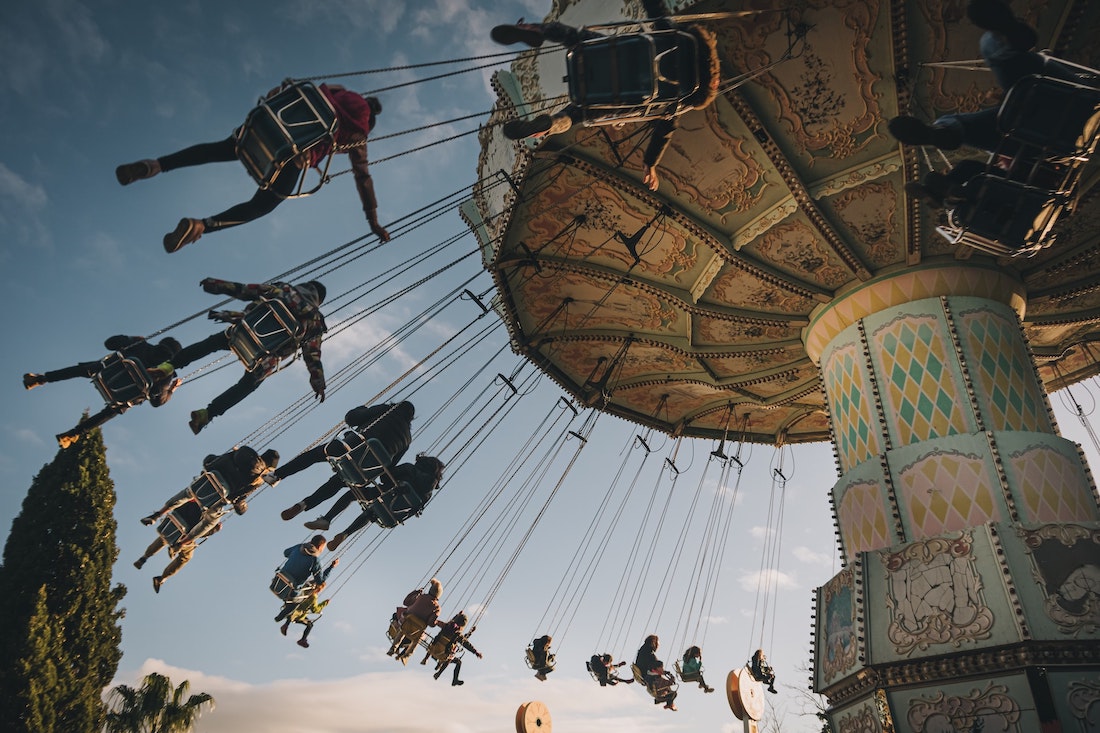
Author: Xavi Cabrera on Unsplash
The highest point of Barcelona and a very beautiful place is Mount Tibidabo. From the height of 512 meters, you can see the majestic Sagrada Familia, the ancient cathedrals of the Gothic Quarter, the beaches with a smell of sunscreen, and the city port with its giant cruise ship and elegant yachts.
Temple and observation deck on Mount Tibidabo
Big Catholic church stands at the top of the mountain, it is built in the best traditions of the Gothic style. The tower's statue of Christ the Savior is above the temple. The stone Christ raised his hands to the sky as if he was embracing the whole city.
This statue was erected to commemorate the passage in the Gospels that tells of Satan lifting Jesus up a high mountain and saying: “I will give you all their authority and splendor; it has been given to me, and I can give it to anyone I want to. If you worship me, it will all be yours.”
To which Jesus answered him, “Worship the Lord your God and serve him only.’" (Luke chapter 4). Thus Jesus showed who the real ruler of the whole universe is, the God who created heaven and earth.
There is an observation deck under the feet of the statue from which you can admire the breathtaking city and sea views and take perfect pictures.
You can get to the observation deck by elevator and by the stairs. Admission to the temple is free and admission to the observation deck is 4 euros.
There is also a crypt in the church, the underground stone chamber with coffins and sarcophagi. The walls are decorated with bas-reliefs, images of biblical stories, and mosaics. Entrance to the crypt is free.
Luna Park on Mount Tibidabo
There is an unusual amusement park a little below the temple. It is interesting because of its picturesque location and history. It's one of the oldest amusement parks in Europe. This amusement park has been working since 1900. And there are still several rides that were built more than a century ago: the Ferris wheel, the air train, the airplane Tibidabo, the chain carousel, and the French carousel with horses. But don't worry about safety, everything is under control.
The most popular is the Ferris wheel. It is small, but what a stunning view of a whole Barcelona opens from it. All its temples and hills, parks and boulevards, beaches, and neighborhoods shine in the sunlight, and this is the best view of the city you may find.
By the way, if you are a Woody Allen fan, keep in mind that several scenes from the movie Vicky Cristina Barcelona were filmed in this amusement park, and you can visit them. And as the film was partly shot in Barcelona you may watch or rewatch it to find some interesting locations to visit.
How to get to the temple and Luna Park on Mount Tibidabo
There are several ways to get to the temple and Luna Park: taxi, bus, train, and cable car.
The easiest way is to take a taxi. The ride from the city center will cost you 15-25 euros one way.
There is a more romantic way to get to Tibidabo.
Take the S1-S2 train at Plaça Catalunya. It takes you to the funicular station (Peu del Funicular). Get a bus number 111 there and in 10 minutes it will get you right in front of the temple on Mount Tibidabo.
Whichever way you choose, wear comfortable shoes and take plenty of water. And get ready to marvel.
Day 4: Mount Montserrat and Montserrat Monastery or Dali Museum
On this day you can choose what you want to see: the whimsically shaped mountains and the Benedictine monastery at the foot of the cliffs, or the surrealistic Dali museum in Girona. Or you may choose both options but it will take you two days.
Perhaps you don't know what to choose and want to see everything and it is possible, you only need to stay in Barcelona for five days or even longer. After all, it is worth it.
The Mountain and Monastery of Montserrat
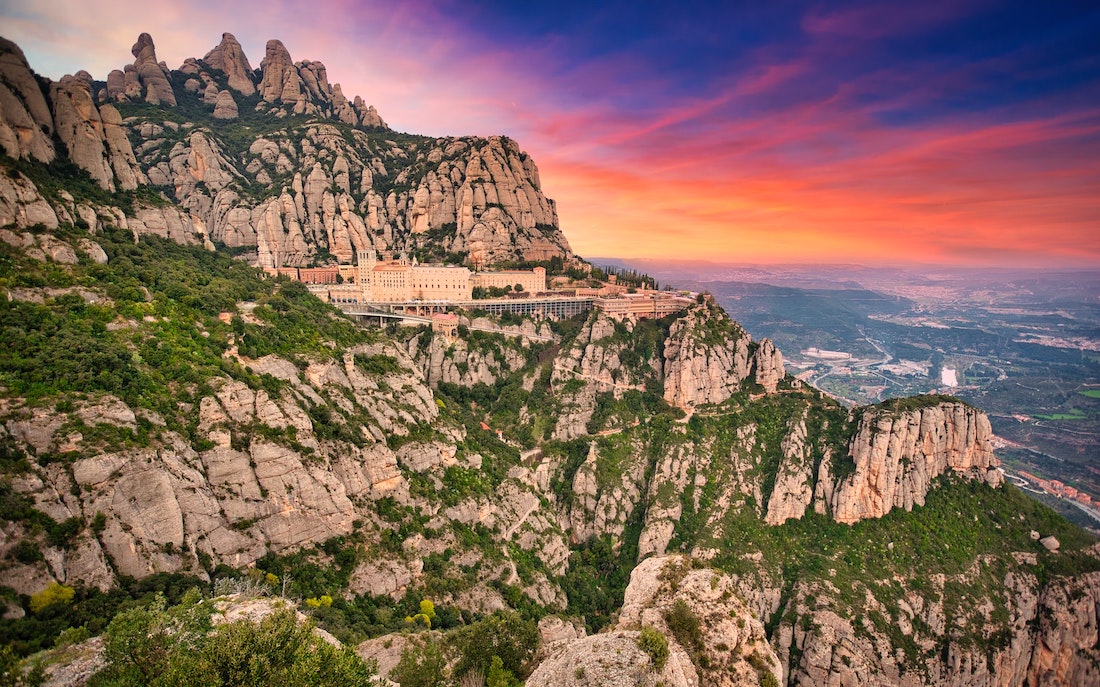
Author: ian kelsall on Unsplash
If you are walking around Barcelona, sooner or later someone will give you a brochure with an offer to go to Mount Monserrat. And we offer you the same.
For centuries these mountains had been resting on the seabed. But after a couple of cataclysms, we all have an opportunity to see the miracle with our own eyes.
The chalk-stone mountain with a very unusual shape rises above the city and its height is 1236 meters. Usually, its top is covered by clouds, but sometimes you can admire the whole marvelous mountain. But better come closer to see all the beauty with your own eyes and even touch it.
Trees do not grow on the rocky slopes, and they are all cut by deep caves, but the piedmont is covered by a beautiful emerald forest.
The ancient Benedictine monastery stands on one of the edges of the mountain. Eighty monks live and work there.
One of the monastery's basilicas carefully preserves a statue of the Black Madonna, which was found more than a thousand years ago in one of the caves. The statue is made of black marble and is covered by gold. Some believe it grants wishes, some use the meeting with a statue as a reason to turn to God, and for some, it is just a work of ancient art. Anyway, this place is worth your time.
The Hotel Abat Cisneros Montserrat is ready to care about your rest, if you want to spend more time in such a picturesque place.
From the monastery, you can take a cable car or a funicular up one of the highest cliffs to walk and admire the views.
How to get to Mount Monserrat from Barcelona
Find the Estació d'Espanya station on Plaça Espanya. You need the R5 platform. Follow the signs and if you are coming to the station for the first time, do it beforehand - the station is usually crowded and the signs are not as accurate as you would like them to be. The train will take you to the foot of Mount Monserrat in an hour. The trains usually run from 8:30 am to 6:30 pm, but you'd better check the schedule beforehand.
At the foot of the mountain, you will find a cable car named Aeri and a funicular named Cremallera. You must decide which of them you will choose and tell a cashier at the ticket office at Estació d'Espanya about your choice. He will give you the necessary ticket.
You can also choose a ticket called Trans Montserrat. It costs 35 euros and includes a round-trip train ticket, two trips on three funiculars (Aeri, which leads to the monastery, and two others that lead from the monastery to the observation decks), and two trips on the regular Barcelona metro. It is beneficial and allows you not to think about anything but beauty.
Our Complete Guide to Montserrat will help you to make a perfect trip
The Dali Museum in Figueres in the province of Girona
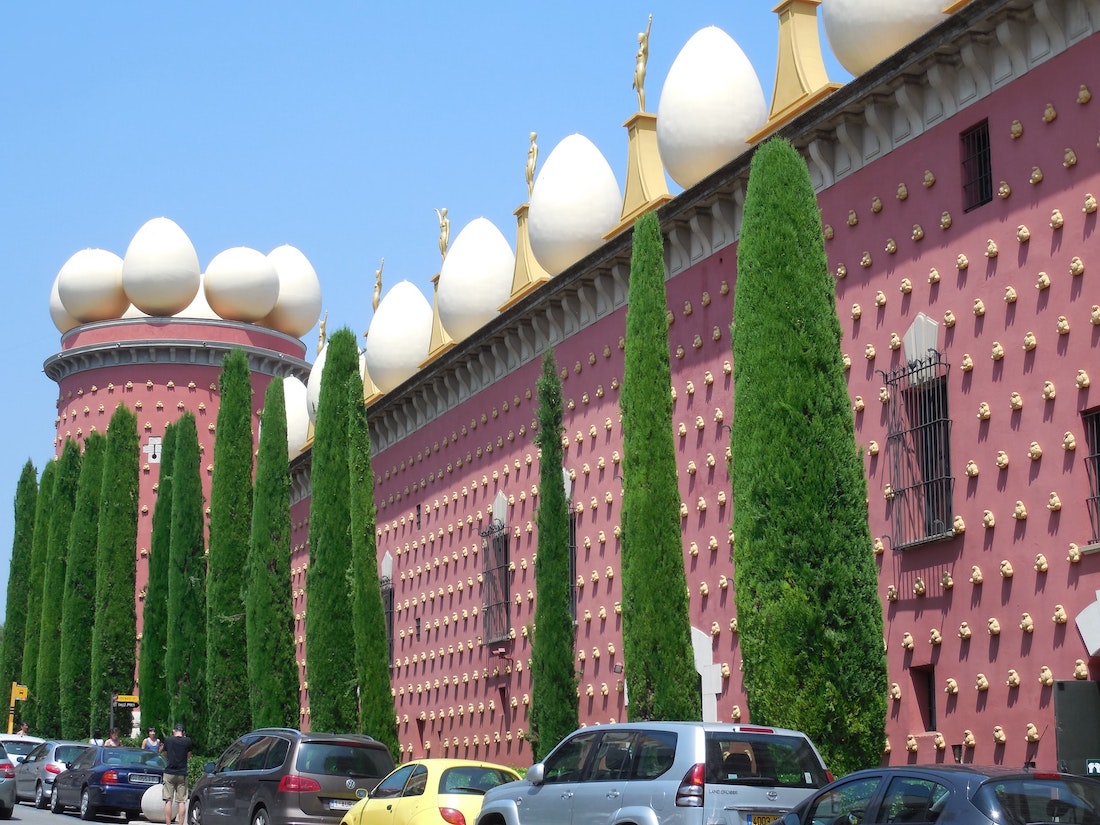
Author: Olesia Libra on Unsplash
If surrealism is not just a sound for you, go to the city of Figueres which is situated in the province of Girona, and there visit the Theater-Museum of Salvador Dali. This trip will take you all day, so it's best to plan your trip in advance.
The outrageous king of surrealism was born in Girona, 100 km from Barcelona. At the age of 14, he presented his work to the public at the local theater. The young artist fell in love with this place, and after 25 years he turned to the local authorities with a proposal to build a new temple of art in the place of the old theater. He had been waiting for the answer for 10 years, but in the end, the theater-museum was built. The construction was personally supervised by Salvador Dali, everything here was and still is surprising. Unusual sculptures, an outlandish stage, a domed glass ceiling, and installations created personally by Dali create the feeling that you are sleeping and see this all in your dream.
The theater-museum consists of several buildings and the most famous of them is called the Galatea Tower. You are greeted by high red walls covered in gold-colored ceramic bread rolls, and huge white eggs lie on the walls. Images of bread and eggs have been important to the artist throughout his life and are present in many of his paintings.
Shortly before his death, Dali moved to the Galatea Tower and died there. According to the will, his body was walled up in the floor of one of the rooms. The artist said that this building fully reflected his personality, character, and thoughts, and after death he would like to merge with these walls.
How to get to the Dali Theater Museum in Figueres from Barcelona
Figueres is located 140 km from Barcelona.
The easiest way to get from Barcelona to Girona is the RENFE intercity train. The train departs from Barcelona Sants station (address: Plaça dels Països Catalans, 1, 7, 08014 Barcelona). Travel time is 2 hours. It will take you 15 minutes from the railway station to the museum.
If you are traveling with a group of several people and you have a lot of luggage, it will be convenient to order a taxi or a transfer. Travel time is about one hour and a half. Order a transfer.
Another option is to buy a tour from Barcelona. The tour includes a round-trip transfer and a guide. Such tours are very convenient because you do not need to think about how to get there and where to go. An experienced guide will meet you in Barcelona, take you to Figueres by comfortable transport, accompany you during a walk through the museum and draw your attention to a thousand details that are so difficult to notice on your own, and also take you to the most interesting places in the city.
Opening hours and prices
The museum is open every day except Monday. Opening hours vary depending on the season.
Before the trip, it is better to check the work schedule on the official website of the museum.
The entrance ticket costs 15-18 euros. The last entry is 45 minutes before the museum closes. That is, if the museum is open until 18.00, you can enter at 17.15 and become the last visitor.
If you don't want to stand in line, buy your ticket online for 17 euros. It is fast and convenient, you do not need to print it, the ticket will be scanned at the entrance directly from your phone.
You may buy one of the Dali-themed tours, for example Girona, Figueres and Dalí Museum Day Tour or Dalí-Themed Cadaqués & Costa Brava Day Trip, during which you will visit the theatre-museum and explore the beauties of the city and the region.
